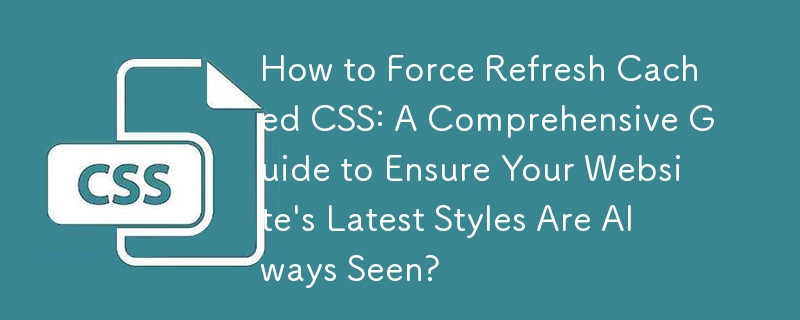Home >Web Front-end >CSS Tutorial >How to Force Refresh Cached CSS: A Comprehensive Guide to Ensure Your Website's Latest Styles Are Always Seen?
How to Force Refresh Cached CSS: A Comprehensive Guide to Ensure Your Website's Latest Styles Are Always Seen?
- Linda HamiltonOriginal
- 2024-11-08 04:34:02654browse

Force Refreshing Cached CSS: A Comprehensive Approach
Introduction
It can be frustrating when changes made to your website's CSS are not immediately visible due to browser caching. This can lead to rendering issues and inconsistent user experiences. To address this, let's explore how to force refresh cached CSS data and ensure that the latest version is always accessed.
TL;DR
- Change the CSS file name or use a unique query string.
- Incorporate a change that occurs only once per release, such as a version number.
- File renaming is preferable to query string changes.
- Optimize HTTP headers to maximize caching benefits.
Observing Caching Behavior
Understanding how different caching techniques behave is crucial. The following table summarizes observed caching behaviors based on file type, expiration settings, and HTTP headers:
| Type | Cache Headers | Observed Result |
|---|---|---|
| Static filename | Expiration 1 Year | Taken from cache |
| Static filename | Expire immediately | Never caches |
| Static filename | None | HTTP 304 (not modified) |
| Static query string | Expiration 1 Year | HTTP 304 (not modified) |
| Static query string | Expire immediately | HTTP 304 (not modified) |
| Static query string | None | HTTP 304 (not modified) |
| Random query string | Expiration 1 Year | Never caches |
| Random query string | Expire immediately | Never caches |
| Random query string | None | Never caches |
Query String Approach
Appending a random query string parameter to the CSS URL will force a new request and the server should respond with HTTP 200. However, randomizing the query string with every request defeats caching entirely. Instead, consider using a build number or date to maintain a few unique URLs.
Path Modification Approach
A more effective solution is to create a new file path. You can automate this process to rewrite the path with a version number or other consistent identifier. This will trigger a new request the first time a user encounters the URL, but subsequent requests will likely return HTTP 304s, reducing data transfer.
File Renaming Approach
File renaming is the simplest method, but it requires manual effort. Rename the CSS files with each release and update the link tags to reference the updated paths.
Conclusion
Understanding the nuances of caching behavior and employing the appropriate techniques ensures that your CSS changes are always reflected accurately. Utilize version-specific file names, unique query strings, or path modifications to force refresh cached CSS data and deliver a consistent user experience across different browsers.
The above is the detailed content of How to Force Refresh Cached CSS: A Comprehensive Guide to Ensure Your Website's Latest Styles Are Always Seen?. For more information, please follow other related articles on the PHP Chinese website!

